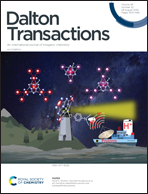Lead(ii) coordination polymers driven by pyridine-hydrazine donors: from anion-guided self-assembly to structural features†
Abstract
In this work, we report extensive experimental and theoretical investigations on a new series of PbII coordination polymers exhibiting extended supramolecular architectures, namely [Pb2(LI)(NCS)4]n (1), [Pb(HLII)I2]n (2), [Pb(LIII)I]n (3) and [Pb(HLIV)(NO3)2]n·nMeOH (4), which were self-assembled from different PbII salts and various pyridine-hydrazine based linkers, namely 1,2-bis(pyridin-3-ylmethylene)hydrazine (LI), (pyridin-4-ylmethylene)isonicotinohydrazide (HLII), 1-(pyridin-2-yl)ethylidenenicotinohydrazide (HLIII) and phenyl(pyridin-2-yl)methylenenicotinohydrazide (HLIV), respectively. It is recognized that the origin of self-assembling is fundamentally rooted in a dual donor (6s2/6p0 hybridized lone electron pair) and electrophilic behaviour of PbII. This allows production of extended topologies from a 1D polymeric chain in 4 through a 2D layer in 2 to the 3D frameworks in 1 and 3, predominantly due to the cooperative action of both covalent and non-covalent tetrel interactions of the overall type Pb–X (X = O, N, S, I). Counterintuitively, the latter, seemingly weak interactions, have appeared to be even stronger than the typical covalent bonds due to the presence of a bunch of supportive London dispersion dominated contacts: π⋯π, Lp⋯π, C–H⋯O, C–H⋯I, C–H⋯H–C as well as more typical mainly electrostatically driven N–H⋯O or N/O–H⋯O hydrogen bonds. It is revealed that the constituting generally strong tetrel type Pb–X (X = O, N, S, I) bonds, though dominated by a classic Coulomb term, are therefore characterized by a very important London dispersion constituent, extremely strong relativistic effects and the two way dative-covalent Pb ↔ X electron charge delocalization contribution as revealed by the Extended Transition State Natural Orbital for Chemical Valence (ETS-NOCV) charge and energy decomposition scheme. It unravels that the pyridine-hydrazine linkers are also excellent London dispersion donors, and that together with the donor–acceptor properties of the heavy (relativistic) PbII atoms and nucleophilic counterions lead to extended self-assembling of 1–4.



 Please wait while we load your content...
Please wait while we load your content...